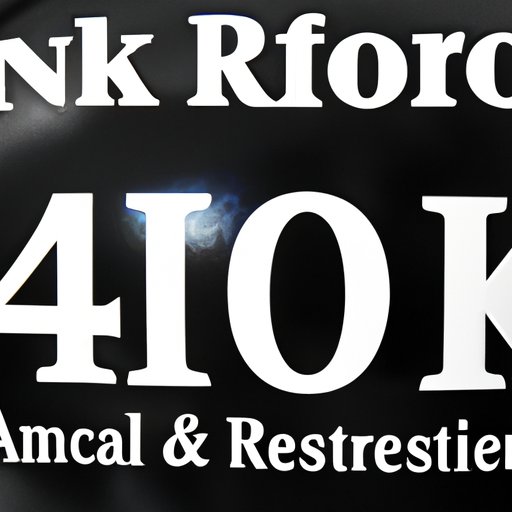Introduction
Retirement savings is an important part of personal financial planning, especially for those without an employer-sponsored plan. For individuals who don’t have access to a 401K through their employer, there are still options available for establishing a retirement savings plan. In this article, we will explore the steps to take when starting a 401K without an employer.
Research 401K Providers That Offer Individual Plans
The first step in starting a 401K without an employer is to research providers that offer individual plans. When researching providers, make sure to look for those that offer low fees, a variety of investment options, and easy account setup and management. Additionally, consider any additional services that may be offered, such as financial advice or educational resources.
When comparing different options, be sure to read the fine print and ask questions to ensure that you understand all the terms and conditions of each provider. Additionally, make sure to check out their customer service ratings and reviews to get an idea of how they handle customer inquiries.
Estimate How Much You Can Contribute to a 401K Each Month
Once you’ve chosen a provider, the next step is to estimate how much you can contribute to a 401K each month. To do this, you’ll need to calculate your monthly budget for retirement savings. Consider factors such as your income, existing debts, and other expenses when determining how much you can afford to save each month.
Keep in mind that the maximum annual contribution limit for a 401K is $19,500 (or $26,000 if you’re 50 or older). While it may not be feasible to contribute the maximum amount each year, it’s beneficial to contribute as much as you can in order to maximize your retirement savings.

Calculate the Tax Benefit of Contributing to a 401K
Contributing to a 401K also provides tax benefits, since contributions are made with pre-tax dollars. This means that you can reduce your taxable income and potentially lower your overall tax bill. It’s important to understand the specific tax advantages of contributing to a 401K so that you can make the most of your retirement savings.
Additionally, there are different types of accounts that offer different tax benefits. Traditional 401K accounts offer tax-deferred growth, while Roth 401K accounts offer tax-free withdrawals in retirement. Depending on your current tax situation and future goals, you may want to consider both options.

Determine Which Type of 401K Account Is Best for You
When deciding which type of 401K account is best for you, consider factors such as your current income level, expected future income level, and tax bracket. Additionally, evaluate your risk tolerance and time frame for retirement. A traditional 401K may be the better option if you expect to be in a higher tax bracket in retirement, whereas a Roth 401K may be better if you expect to be in a lower tax bracket.

Set Up Automatic Contributions from Your Bank Account
Setting up automatic contributions from your bank account is a great way to stay on track with your retirement savings goals. Most providers allow you to set up recurring contributions from your checking or savings account. This makes it easy to save without having to remember to transfer money each month.
Additionally, setting up automatic contributions allows you to take advantage of dollar-cost averaging, which helps to minimize the impact of market volatility on your investments. Plus, it can help you maintain a consistent savings rate over time.
Consider Setting Up an IRA in Addition to a 401K
In addition to a 401K, you may want to consider setting up an IRA. IRAs provide similar tax benefits as 401Ks and offer more flexibility with regard to investment choices. Additionally, having both a 401K and an IRA can increase the amount of money you can save for retirement.
However, it’s important to keep in mind that there are limits to how much you can contribute to both a 401K and an IRA each year. Make sure to review these limits before setting up your accounts.

Monitor Your Investments and Review Fees Regularly
Finally, it’s important to monitor your investments and review fees regularly. By monitoring your investments, you can ensure that your portfolio is aligned with your long-term goals and make any necessary adjustments. Additionally, it’s important to review fees regularly to make sure that you’re not paying too much for your investments.
Conclusion
Starting a 401K without an employer can seem overwhelming, but it is possible. By following these steps, you can establish a retirement savings plan that will help you reach your long-term financial goals. Research providers, estimate your contributions, understand the tax benefits, set up automatic payments, and monitor your investments and fees regularly.
Taking action now can make a big difference in the future. So start researching today and get on the path to a secure retirement.
(Note: Is this article not meeting your expectations? Do you have knowledge or insights to share? Unlock new opportunities and expand your reach by joining our authors team. Click Registration to join us and share your expertise with our readers.)
